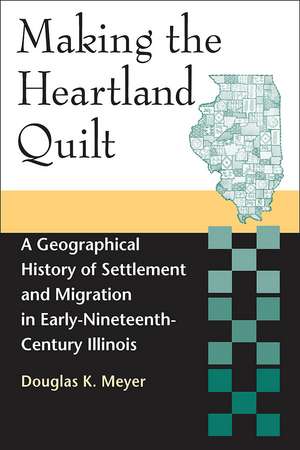Making the Heartland Quilt: A Geographical History of Settlement and Migration in Early-Nineteenth-Century Illinois
Autor Douglas K. Meyeren Limba Engleză Paperback – 24 mar 2016
In Making the Heartland Quilt, Douglas K. Meyer reconstructs the settlement patterns of thirty-three immigrant groups and confirms the emergence of discrete culture regions and regional way stations. Meyer argues that midcontinental Illinois symbolizes a historic test strip of the diverse population origins that unfolded during the Great Migration. Basing his research on the 1850 U.S. manuscript schedules, Meyer dissects the geographical configurations of twenty-three native and ten foreign-born adult male immigrant groups who peopled Illinois. His historical geographical approach leads to the comprehension of a new and clearer map of settlement and migration history in the state.
Meyer finds that both cohesive and mixed immigrant settlements were established. Balkan-like immigrant enclaves or islands were interwoven into evolving local, regional, and national settlement networks. The midcontinental location of Illinois, its water and land linkages, and its lengthy north-south axis enhanced cultural diversity. The barrier effect of Lake Michigan contributed to the convergence and mixing of immigrants. Thus, Meyer demonstrates, Illinois epitomizes midwestern dichotomies: northern versus southern; native-born versus foreign-born; rural versus urban; and agricultural versus manufacturing.
Preț: 269.24 lei
Preț vechi: 332.08 lei
-19% Nou
Puncte Express: 404
Preț estimativ în valută:
51.52€ • 55.95$ • 43.28£
51.52€ • 55.95$ • 43.28£
Carte indisponibilă temporar
Doresc să fiu notificat când acest titlu va fi disponibil:
Se trimite...
Preluare comenzi: 021 569.72.76
Specificații
ISBN-13: 9780809335145
ISBN-10: 080933514X
Pagini: 354
Ilustrații: 67
Dimensiuni: 152 x 229 x 23 mm
Greutate: 0.48 kg
Ediția:1st Edition
Editura: Southern Illinois University Press
Colecția Southern Illinois University Press
ISBN-10: 080933514X
Pagini: 354
Ilustrații: 67
Dimensiuni: 152 x 229 x 23 mm
Greutate: 0.48 kg
Ediția:1st Edition
Editura: Southern Illinois University Press
Colecția Southern Illinois University Press
Notă biografică
Douglas K. Meyer is a professor emeritus of geography at Eastern Illinois University. He is a coauthor of both Common Houses in America’s Small Towns: The Atlantic Seaboard to the Mississippi Valley and Pictorial Landscape History of Charleston, Illinois. Since his retirement in July, 2000, he has traveled extensively in the United States, Europe, and Australia/New Zealand. His passion, however, remains his English cottage garden with its azaleas, rhododendrons, hostas, daylilies, oriental lilies, and Japanese maples.
Recenzii
“Anyone interested in regional culture soon comes to appreciate studies of population origin. Birthplace information for early settlers provides the best measure available for migration patterns. It also has proved important in understanding past and present variations in agricultural practices, architecture, political behavior, and even the growth of cities. Douglas Meyer has devoted his scholarly life to tabulating and interpreting heretofore unpublished birthplace data from the 1850 Illinois census. We should be grateful for his efforts.”—The Annals of Iowa
“Meyer’s work provides impressive evidence of the demographic, economic, and settlement dynamics in the state of Illinois in the middle of the nineteenth century, out of which emerged a distinctive midwestern culture that would subsequently influence national culture.”—The American Historical Review
“Meyer’s work provides impressive evidence of the demographic, economic, and settlement dynamics in the state of Illinois in the middle of the nineteenth century, out of which emerged a distinctive midwestern culture that would subsequently influence national culture.”—The American Historical Review
Descriere
This book reconstructs the settlement patterns of thirty-three immigrant groups and confirms the emergence of discrete culture regions and regional way stations. Meyer argues that midcontinental Illinois symbolizes a historic test-strip of the diverse population origins that unfolded during the Great Migration.
